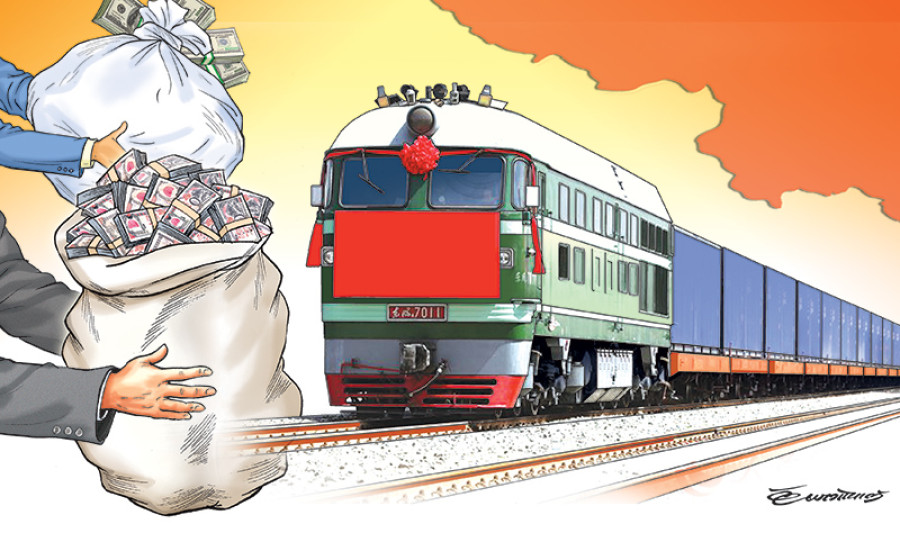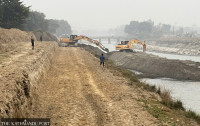National
Nepal, China agree on rail study
Nepal and China have agreed on the technical details of the Kathmandu-Kerung railway line, and will soon begin the process of preparing a detailed report for what has been touted as one of the most challenging projects, even for the northern neighbour that has mastered advanced railway engineering.
Anil Giri & Sanjeev Giri
Nepal and China have agreed on the technical details of the Kathmandu-Kerung railway line, and will soon begin the process of preparing a detailed report for what has been touted as one of the most challenging projects, even for the northern neighbour that has mastered advanced railway engineering.
Government officials who returned to Kathmandu after a week-long visit to the Chinese north-central city of Xi’an told the Post that the two sides have reached a mutual agreement over the technical study conducted by China Railway First Survey and Design Institute.
“The governments of Nepal and China have given a green light following the outcome of the technical study,” Department of Railways (DoR) Director General Ananta Acharya told the Post.
Acharya said a team from the Chinese side would visit Nepal before November this year for further discussions, during which both sides are expected to reach an agreement on preparing the Detailed Project Report (DPR) of the multi-billion rail project.
Before that, the Nepali team in Xi’an, led by the Ministry of Physical Infrastructure and Transport Secretary Madhusudhan Adhikari, will update government officials and the line ministry about the findings of the report. The proposal from the Chinese side will then be taken to the top political leadership, including Prime Minister KP Sharma Oli.
Because the governments of both countries have agreed on the technical aspects of the project, officials said the process for the development of DPR would be expedited.
“It will take around one and a half year to complete DPR,” Acharya said, adding that the report will provide a detailed account of the construction plan as well as the project cost.
Preliminary study suggests the cross-border project is estimated to cost Rs257 billion. It will take around nine years for the project to complete.
There has been one change in the construction plan for the project. The railway station in Kathmandu, which was previously supposed to be built in Manamaiju, has been altered according to the officials involved in the technical assessment. The Chinese side, based on the technical study, has recommended that the railway station in Kathmandu should be situated in Sankhu, which would shorten the total distance of the railway line. Officials say the new station area is also expected to be more feasible for the development of a railway platform.
According to a senior official at the Ministry of Physical Infrastructure and Transport Management, the railway line from Kerung will pass through the Langtang region bordering the Chinese territory, into Tibet and then Melamchi before terminating at Sankhu in Kathmandu. The total of the railway line inside the Nepali territory is expected to measure about 72.25km, the official said.
A copy of the technical report obtained by the Post last week states that the railway line will need construction of ramps along the northern slopes leading to Lake Paiku, near Kerung, to connect the tracks to the Kathmandu section.
The goals of the ramps would be to overcome the huge difference in elevation between the southern and northern toes of the Himalayan mountains.
Because of the severe topographical issues of the proposed line, the speed of rail connecting Nepal with China will be set at less than 100km per hour. The railway track will be initially used for hauling cargo and will be gradually upgraded into a passenger transit system.
Because at least 98.5 percent of the rail will be within either a tunnel or a bridge, the passenger rail will be oxygenated. There will be four stations planned along the railway line.
Nepali authorities who returned from Xi’an say that factors like high gradient, steep-slope, complex geographical terrain, and seismic vulnerability at numerous locations demand frequent drilling in several parts of the rail route during the construction phase.
Though the government team refused to disclose details on financial modality and project financing, a senior Transport Ministry official told the Post that the Chinese side has hinted that it would extend loan support for financing the project. The Nepali side, however, is rooting for a grant or partial grant agreement.
But technical experts with the knowledge of the project say that Nepali government does not need any monetary assistance to fund the project.




 11.12°C Kathmandu
11.12°C Kathmandu
















